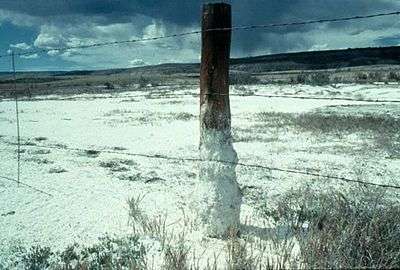U.S. Salinity Laboratory
The U.S. Salinity Laboratory is a National Laboratory for research on salt-affected soil-plant-water systems. It resorts under the Agricultural Research Service (ARS) of the United States Department of Agriculture (USDA) and is located in Riverside, California, U.S.A.

The mission of its staff is to develop, amongst other, new knowledge and technology for crop production on salt-affected lands.[1]
History
The Lab started its operations in 1947 at Riverside.[2]
In 1954 one of the first all encompassing publications, the USDA Agriculture Handbook No. 60, has seen the light [3]
Research focus

The model for salt tolerance of crops stems from Riverside.[4]
Saline and alkali soil conditions reduce the value and productivity of considerable areas of land in the United States. The problem is an old one, and there is much information on this subject in the technical literature. Many crop failures result from growing crops that have low salt tolerance. Alfalfa, barley, sugar beets, and cotton are tolerant crops that can often be grown where salinity is a problem.[3]
Data bases
The Salinity Laboratory keeps data bases of salt tolerance of crops divided into 5 groups: 1) Fiber, Grain and Special Crops, 2) Grasses and Forage Crops, 3) Vegetables and Fruit Crops, 4) Woody Crops, 5) Ornamental Shrubs, Trees and Ground Cover.[5]
Salinity models
Software for quite a number of soil salinity models covering different aspects was developed at Riverside, including the Hydrus model [6] and the Van Genuchten–Gupta model.[7]
References
- USDA-ARS, Basic research on the chemistry, physics, and biology of salt-affected soil-plant-water systems. On line:
- USDA-ARS, History of the Salinity Lab. On line
- L. A. Richards, Editor, 1954. Diagnosis and Improvement of Saline and Alkali Soils. USDA Agriculture Handbook No. 60 prepared by United States Salinity Laboratory Staff, Agricultural Research Service. On line:
- Maas EV, Hoffman GJ, 1977. Crop salt tolerance-current assessment. Journal of the Irrigation and Drainage Division, American Society of Civil Engineers 103: 115-134.
- U.S. Salinity Laboratory, United States Department of Agriculture, Agricultural Research Service, USSL Research Databases. On line:
- U.S. Salinity Laboratory, United States Department of Agriculture, Agricultural Research Service, Model Descriptions. On line:
- M. Th. van Genuchten and S.K. Gupta, 1993. USDA-ARS, U.S. Salinity Laboratory 4500 Glenwood Drive, Riverside, California, USA 92501. A reassessment of the Crop Tolerance Response Function. Journal of the Indian Society of Soil Science, Vol. 41, No. 4, pp 730–737. USDA-ARS, U.S. Salinity Laboratory 4500 Glenwood Drive, Riverside, California, USA, 92501